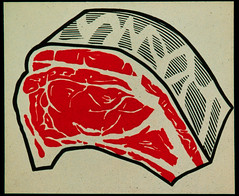December 21
The weather continues to be dreadful. We got ice on top of 6+ inches of snow and it’s back to snowing full bore again. Last night’s meal of small plates ended after two courses, because the plates weren’t as small as I had thought.
I started with mushrooms sautéed in olive oil with fresh rosemary, garlic and amontillado sherry. I had bought enough mushrooms for four but ended up cooking for two, so our first course was actually double sized. I paired it with a Sierra Nevada Celebration ale, which for those who don’t know it, is essentially an American IPA. I was thinking the piney flavors and aromas of the Cascade hops would pair nicely with piney-ness of the rosemary and it did work out pretty well. The spelt bread was good but not as crusty as I like but it was certainly loads better than the typical things that pass as baguettes or rustic breads at the average supermarket bakery (which is too often home to characterless “French” and “Italian” bread).
The second course was shrimp escasbeche. Escabeche is a family of Spanish dishes that are essentially pickled. They originate from the days before refrigeration where foods were cooked in olive oil and vinegar and then left to sit in it. The large amounts of vinegar and oil acted a preservative and allowed people to keep poultry and fish for longer periods. Today it’s still cooked because people enjoy the flavors. You can pretty much cook anything escabeche and then serve it hot, cold or room temperature. I start by heating olive oil gently and then adding onions and garlic and letting them cook down slowly and infuse the oil. Later I add some herbs (more rosemary in this case because it’s still sticking out above the snow) and then vinegar and a little white wine. Once this mixture comes together, add the main ingredient. I this case it was shrimp. Because they cook fairly quickly, I turn the heat off after I add them and pull the pan from the burner and let them finish cooking in the residual heat. If you’re cooking something more substantial, like chicken pieces, you can put the pot in the oven and leave it for 1-2 hours on a low heat.
To serve it, remove the main ingredient (the shrimp in my case), and then ladle some of the sauce into another pan and reduce it by about a third or half. Then pour the sauce over the shrimp and serve it with crusty bread. I actually had some homebrewed pilsner with this one. Not for any reason other than the fact that I love good pilsner and still think it’s one of the most food friendly beer. Although Spain is considered a wine drinking country, I prefer beer with foods cooked with a lot of vinegar since vinegar can make most wines taste thin and sharp. The malt sugar and the hop bitterness of pilsner actually stands up better (but a good lambic or acidic wit bier would be very nice as well).
Tonight I’m sticking to something simple: a spinach, caramelized onion and goat cheese pie. The crust is made form olive oil instead of shortening which gives it a distinctive taste. No idea what I’ll drink with it yet, but I’m sure I’ll find something.
Sunday, December 21, 2008
What to eat during a snow storm - Part 2
Posted by
Bill
at
3:49 PM
![]()
![]()
Labels: escabeche, goat cheese, olive oil pastry, pilsner, sierra nevada, spinach
Subscribe to:
Post Comments (Atom)

2 comments:
The eschebeche sounds great. What else works with that? You mentioned chicken. How about pork?
You could essentially do it with any type of protein. Fish and poultry are traditonal, but pork would work as well.
Post a Comment